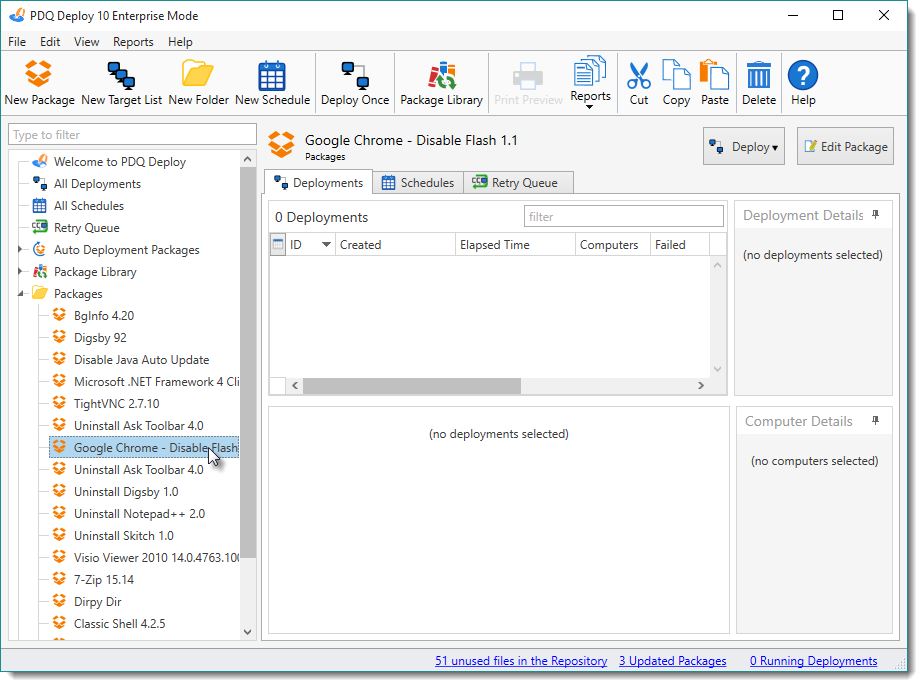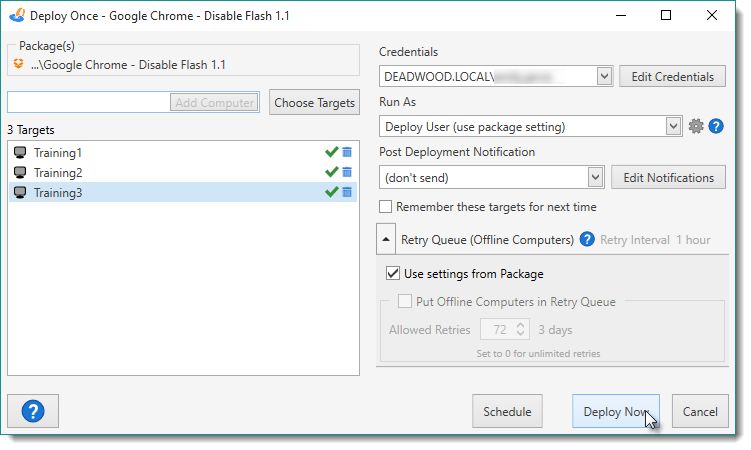Use Deploy Once when you want to quickly and easily deploy a single package. For instructions on how to use Deploy Once for multiple imported packages, see Deploying Multiple Packages with Deploy Once. For instructions on how to use Deploy Once for an Auto Deployment Package (Enterprise mode required), see Deploying an Auto Deployment package with Deploy Once. For an introduction to the Deploy Once window, see Deploy Once Window.
To create a manual deployment for a single package using Deploy Once:
1.On the Main Console window, select the package you want to deploy.

2.Do one of the following:
•On the Toolbar, click Deploy Once ![]() .
.
•Click File > Deploy Once (or press Ctrl+D or right-click and select Deploy Once).
•On the selected Package window, click Deploy > Deploy Once.
A new Deploy Once window opens.
3.(Optional) To manually add a target computer to the list, type a computer name in the Enter Computer Name field, then click Add Computer. Alternately, you can also paste a target computer name (or list of names) directly into the Targets area of the window. If copying a list of names, ensure that there is only one target computer name per line.
When you add a target computer manually, the name appears in the Target(s) list and the system (DNS) checks to be sure it exists on the network. Targets resolved by DNS appear with a green checkmark ![]() .
.
4.(Optional) To add target computers using external sources, click Choose Targets, then select a source:
Source |
Description |
Active Directory |
Select target computers from Active Directory containers or groups. |
PDQ Inventory |
Select target computers from PDQ Inventory Collections. |
Spiceworks |
Select target computers from Spiceworks Groups. |
Target List |
Select target computers using other PDQ Deploy Target Lists. |
Text File |
Select a text file containing a list of target computer names. |
When you build a target list with Choose Targets using external sources, you select specific target computers, no matter how you browse for them. For details, see Creating a Target List, Part 2: Choose Targets.

5.Define the Deployment settings you want to apply to the deployment.
The following table provides information on the Deployment settings available in the Deploy Once window:
Option |
Details |
|
The credentials used by all deployments from the current deployment. For more information see Credentials in Preferences. This is the username and password used to connect to the target computer and copy over the necessary files and start the target service. This user must have administrative rights on the target computer, which are needed to copy files to the ADMIN$ share and create and start the remote service. It can be a user account local to the target computer or a domain user if using Active Directory. |
||
Determines how the current deployment is executed on target computers. Note: The Run As settings at the Package level may be superseded by any explicit Run As settings at each Step level. For a sample demonstration of the Run As options, see the following video. VIDEO: Deployment Run As Options
(http://www.adminarsenal.com/videos#!deployment-run-as-options) |
||
Deploy User |
Silently executes deployments on target computers. This setting is appropriate for the vast majority of deployments. |
|
Deploy User (Interactive) |
Executes deployments that include both silent and interactive steps. This setting is the same as Deploy User with one important exception—the Windows process running the deployment is run in interactive mode. This setting is most appropriately used for individual deployments that require user input, but the overall process still requires Administrator rights that logged on users may not have. This type of deployment requires more processing resources. IMPORTANT: This feature is available only in Pro or Enterprise mode. |
|
Local System |
Executes deployments using the local System account on the target computer. PDQ Deploy connects to the target computer, copies the specified files, then runs the actual deployment service using the Local System credentials. This setting is used only for installations that require Local System. These types of deployments are very rare. |
|
Logged on User |
Attempts to run packages in Interactive mode as the Logged On User of the target machine. This setting is used to deploy applications that are installed per user or when the logged on user needs to provide information for the deployment to succeed such as a license key. It can also be used to modify the HKEY-CURRENT-USER registry hive for the logged on user or to access user-specific settings such as %APPDATA% or the logged on user’s User directory. IMPORTANT: This feature is available only in Pro or Enterprise mode. |
|
Sends an email notification when the deployment finishes. (Pro or Enterprise mode required.) Select one of the two default post deployment notifications, Full Details or Summary, or create a custom notification by clicking Edit Notifications. For more information about post deployment emails, see Receiving a Status Email After Deployment and Mail Server Preferences. IMPORTANT: You must configure the Mail Server settings in Preferences as well as designate at least one email recipient in the selected Post Deployment Notification before you can enable this option. |
||
Remember these targets for next time |
Saves the list of targets to use the next time you start a deployment with Deploy Once. |
|
Retry Queue settings determine how PDQ Deploy handles deployments when the target computers are offline. |
||
Use settings from Package |
Uses the Retry Queue settings defined at the Package level. For more information, see Creating a New Package, Step 1: Package Properties. If you select this option but Retry Queue settings are not defined at the Package level, then PDQ Deploy uses the global Offline settings defined in Preferences. When you select this option, the subsequent Retry Queue settings are disabled. |
|
Put Offline Computers in Retry Queue |
Enables the Retry Queue. By default, target computers that are unreachable or offline during a deployment are held in the Retry Queue and deployment is retried. |
|
Allowed Retries |
Sets the number of retry attempts for an offline computer. This applies per target per deployment. The default setting is 72. To set unlimited retries, set this value to 0. |
|
6.(Optional) If you decide to schedule the deployment rather than run it immediately, click Schedule.
For information about scheduling deployments, see Creating Scheduled Deployments.
7.When you are ready to execute the deployment, click Deploy Now.

8.View the progress and the status of the deployment in Deployment Status in the Main Console Window.
During a deployment you can stop deploying to one or more of the pending target computers by right-clicking on the target(s) and clicking Abort. To retry deployments to computers that fail, right-click the target, and click Redeploy or press Ctrl+R. If a deployment to a target computer fails, you can view details about the failure and possible solutions by clicking the More Info link or the Steps link.
For more information about what happens during and after a deployment, see Verifying Deployment Status.
© 2016 Admin Arsenal, Inc. All rights reserved.
Admin Arsenal is a trademark of Admin Arsenal, Inc. All other product and company names are the property of their respective owners.
Help Version: 10.2.0.0